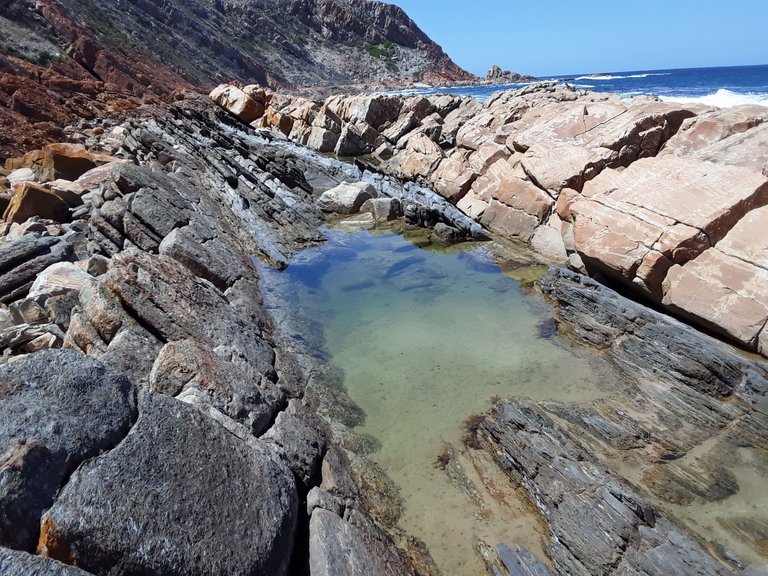Geology and geography lovers will appreciate this particular series of photos today. I took these recently on my cliff hikes along the southernmost shoreline of Africa, in a region called The “Garden Route” which is a famous tourist paradise for those who know about it. These particular photos are from a very remote stretch of the coastline that is isolated and deserted, with hardly ever any people visiting it.

If you look at the photos you will notice a peculiar slither of rock wedged in between some other rock layers, like slices of bread laid next to each other. The primary rock appears to be ochre in color, sometimes becoming brightly burnt orange. Yet slipped in between these layers is this other slate grey layer of rock which I presume is granite. And the sea waves wash up against them at the shore line on this stretch of the rugged and remote coastline.

They lie at a perpendicular slant, in line with the bigger cliffs that they are part of. And they fall straight into the sea at the water’s edge. I find it curious how this one thin slither of granite is wedged in between the other generic rock all around it. It appears as if just this one long seem of granite found its way in and amongst the sandstone, or whatever the other rock might be. It makes a distinct contrast between the orange and the grey rock striations.

And in the darker grey rock you can see straight parallel lines of erosion or weathering presumably caused by the sea water as it washes up onto the rock over the millennia. The amazing patterns and sense of straight even lines which go on for hundreds of meters or yards, give the place a deliberate look, even if these geometric patterns are all totally random or made by nature. Where the hungry person just sees a place to possibly catch fish or forage for rock mussels, I as an artist just see a gallery full of abstract modern art sculptures carved by Mother Nature.

The geologist might of course see what is really presenting itself here, namely diverse rock types lying together in natural formation based on the seismic shifts of the earth’s crust. And they would recognize the types of rock and the style of erosion, which to me looks like neat patterns made by a ruler. Beauty is in the eye of the beholder, as the saying goes, and so too is life as a whole. We all perceive our reality around us from our personal subjective point of view, based on our conditioning, training and instinct.

Some might see this landscape as hard, bare and barren, which it is in one sense. Yet I see it as pure and clean and pristine, untouched by human hand, timeless except for the slow erosion that occurs over millennia. I see vast wide open skies and ocean, filled with light and fresh air, all uplifting to the mood. But that’s because I come down here on my hikes after a good meal and with a warn soft shelter to return to at night.
If one were stranded here without food or water, it might look more desolate and desperate, like a desert, though not quite as unforgiving. At least there may be sea life from which to forage and there is wood for a fire – if you can ignite a flame. And there are occasional little streams of fresh water springing out of the rock or running down the slopes. Perhaps the geologists could explain to us this unusual slither of granite wedged between the rest of the general rock type on this coast line. I am always curious to know what’s going on beneath my feet.
(photos my own)
Amazing
Thank you for sharing
My pleasure, welcome to Hive.